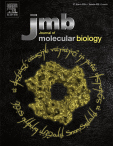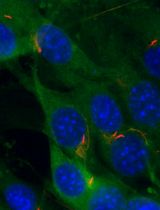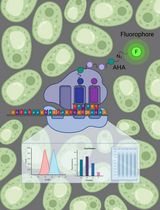- EN - English
- CN - 中文
Nitroxide Labeling of Proteins and the Determination of Paramagnetic Relaxation Derived Distance Restraints for NMR Studies
蛋白质的硝基氧标记和NMR的顺磁弛豫衍生距离约束的测定
发布: 2017年04月05日第7卷第7期 DOI: 10.21769/BioProtoc.2207 浏览次数: 11859
评审: Marc-Antoine SaniAshish SethiAnonymous reviewer(s)
Abstract
Site-specific attachment of paramagnetic spin labels to biomolecules causes distance-dependent line-broadening effects, which can be exploited to study the structure and dynamics of these molecules in solution. This protocol describes how to attach nitroxide spin labels to proteins and how to collect and analyze NMR data using these labeled samples. We also explain how to derive distance restraints for paramagnetic relaxation enhancement nuclear magnetic resonance (PRE-NMR) studies.
Keywords: Paramagnetic relaxation enhancement (顺磁弛豫增强)Background
This protocol describes how to attach nitroxide spin labels to proteins and how the modified proteins can be employed to derive distance restraints using paramagnetic relaxation enhancement nuclear magnetic resonance (PRE-NMR) methods. Site-specific attachment of paramagnetic spin labels to proteins enhances the transverse relaxation rates of nearby nuclei leading to line-broadening effects that can be used to derive distance restraints (Battiste and Wagner, 2000; Iwahara et al., 2004; Clore and Iwahara, 2009). PRE-derived distance restraints have been used to characterize the structures of various molecules, including amongst others membrane proteins (Roosild et al., 2005), multi-domain proteins displaying inter-domain dynamics (Sjodt et al., 2016), single domain proteins (Battiste and Wagner, 2000), protein-DNA complexes (Clore and Iwahara, 2009), transient protein-protein interactions (Tang et al., 2007; Villareal et al., 2011), and intrinsically disordered proteins (Bertoncini et al., 2005). Two approaches are generally used to obtain PRE-derived distance restraints using proteins that are labeled with paramagnetic probes. The first method quantitatively measures the probe’s effects on the transverse relaxation rates of nearby protein nuclei by determining Γ2 (described in detail by Iwahara and Clore) (Iwahara et al., 2004; Clore and Iwahara, 2009). The second method is less quantitative, but in practice it is easier to implement. It was originally employed by Battiste and Wagner, and measures the probe’s effects by comparing cross-peak intensity ratios in diamagnetic- and paramagnetic-spectra of the labeled protein (Battiste and Wagner, 2000). The nitroxide spin label MTSL is frequently used as a paramagnetic probe in PRE-NMR studies of proteins because it is readily attached via a disulfide bond to cysteine residues, and also relatively small, inexpensive, and commercially available. The aim of this protocol is to describe how to attach MTSL nitroxide spin labels to proteins and how to derive PRE-distance restraints following the approach described by Battiste and Wagner (2000).
Materials and Reagents
- Amber vial
- Desalting spin column, for example, a ZebaTM spin desalting column, 7k MWCO, 2 ml (Thermo Fisher Scientific, Thermo ScientificTM, catalog number: 89889 )
- 15 ml conical test tube
- Aluminum foil
- A centrifugal filter, such as Amicon Ultra-15 centrifugal filter (EMD Millipore, catalog number: UFC900308 )
- Standard 5 mm NMR tube (SP Industries, catalog number: 535-PP-7 )
- 2D [1H-15N]-HSQC spectrum of the native protein acquired using standard methods (Cavanagh et al., 1995)
- Dithiothreitol (DTT); > 99% purity (Gold Bio, catalog number: DTT50 )
- Deuterium oxide (D2O); ≥ 99.8% purity (Sigma-Aldrich, catalog number: 617385 )
- Tris(hydroxymethyl)aminomethane hydrochloride (Tris-HCl); ≥ 99% purity (Fisher Scientific, catalog number: BP153 )
- Sodium chloride (NaCl); ≥ 99% purity (Fisher Scientific, catalog number: S271 )
- S-(1-oxyl-2,2,5,5-tetramethyl-2,5-dihydro-1H-pyrrol-3-yl)methyl (MTSL) methanesulfonothioate (Toronto Research Chemicals, catalog number: O875000 )
- Acetonitrile; ≥ 99.9% purity (Fisher Scientific, catalog number: A996 )
- Sodium phosphate monobasic (NaH2PO4); ≥ 98% purity (Fisher Scientific, catalog number: S369 )
- Sodium azide; ≥ 99% purity (Fisher Scientific, catalog number: S227I )
- Sodium ascorbate; ≥ 98% purity (Sigma-Aldrich, catalog number: A7631 )
- Labeling buffer (see Recipes)
- 200 mM MTSL stock solution (see Recipes)
- Example NMR buffer (see Recipes)
- 250 mM sodium ascorbate stock solution (see Recipes)
Note: These reagents were used to obtain the PRE data according to Sjodt et al., 2016. However, other brands of these materials may be used if necessary.
Equipment
- Centrifuge (Beckman Coulter, model: Allegra X-14R )
- SX4750A swinging bucket rotor (Beckman Coulter, model: SX4750A ARIESTM Roter )
- MALDI-TOF mass spectrometer (Thermo Fisher Scientific, Applied BiosystemsTM, model: Voyager-DE-STR )
Note: This product has been discontinued. Examples of other MALDI-TOF instruments include Shimadzu, model: AXIMA Assurance Linear MALDI-TOF ; Bruker, model: microflex LT/SH . - NMR experiments system
Note: NMR experiments used in this protocol are part of the Bruker standard pulse sequence library and were performed on Bruker Avance spectrometers equipped with triple-resonance cryogenic probes (Bruker Corporation).
Software
- NMRPipe (Delaglio et al., 1995)
https://www.ibbr.umd.edu/nmrpipe/install.html - Bruker TopSpinTM
https://www.bruker.com/nc/service/support-upgrades/software-downloads/nmr/free-topspin-processing/download-page.html - Sparky (Goddard and Kneller, 2008)
https://www.cgl.ucsf.edu/home/sparky/ - Microsoft Excel
https://products.office.com/en-us/excel - XPLOR-NIH (Schwieters et al., 2003)
https://nmr.cit.nih.gov/xplor-nih/
Procedure
文章信息
版权信息
© 2017 The Authors; exclusive licensee Bio-protocol LLC.
如何引用
Sjodt, M. and Clubb, R. T. (2017). Nitroxide Labeling of Proteins and the Determination of Paramagnetic Relaxation Derived Distance Restraints for NMR Studies. Bio-protocol 7(7): e2207. DOI: 10.21769/BioProtoc.2207.
分类
生物化学 > 蛋白质 > 标记
您对这篇实验方法有问题吗?
在此处发布您的问题,我们将邀请本文作者来回答。同时,我们会将您的问题发布到Bio-protocol Exchange,以便寻求社区成员的帮助。
提问指南
+ 问题描述
写下详细的问题描述,包括所有有助于他人回答您问题的信息(例如实验过程、条件和相关图像等)。
Share
Bluesky
X
Copy link












